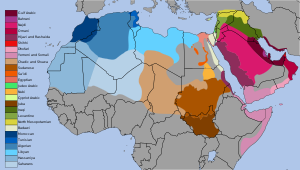Ethnic groups in the Middle East: Difference between revisions
Moudinho1996 (talk | contribs) No edit summary Tags: Mobile edit Mobile app edit iOS app edit |
fuxed typo Tags: Reverted Mobile edit Mobile web edit |
||
| Line 1: | Line 1: | ||
{{short description|Overview of ethnic groups in the Middle East}} |
{{short description|Overview of ethnic groups in the Middle East}} |
||
[[File:Ethnolinguisticswasiacia.jpg|thumb|260px|Ethnolinguistic distribution in Central/Southwest Asia of the [[Altaic languages|Altaic]], [[Caucasian languages|Caucasian]], [[Afroasiatic languages|Afroasiatic]] (Hamito-Semitic) and [[Indo-European languages|Indo-European]] families.]] |
[[File:Ethnolinguisticswasiacia.jpg|thumb|260px|Ethnolinguistic distribution in Central/Southwest Asia of the [[Altaic languages|Altaic]], [[Caucasian languages|Caucasian]], [[Afroasiatic languages|Afroasiatic]] (Hamito-Semitic) and [[Indo-European languages|Indo-European]] families.]] |
||
The '''ethnic groups in the Middle East''' |
The '''ethnic groups in the Middle East'''s well as [[Egypt]] in [[North Africa]], a transcontinental region commonly known as the [[Middle East]]. The region has historically been a crossroad of different cultures. Since the 1960s, the changes in political and economic factors (especially the enormous oil wealth in the region and conflicts) have significantly altered the ethnic composition of groups in the region. While some ethnic groups have been present in the region for millennia, others have arrived fairly recently through [[immigration]]. The largest ethnic groups in the region are the [[Arabs]], [[Kurds]], [[Persians]], and [[Turkish people|Turks]],[[Armenians]] <ref>{{cite book|url=https://books.google.com/books?id=SPBfnT_E1mgC&pg=PA16 |title=Ethnic Groups of Africa and the Middle East: An Encyclopedia|access-date=26 May 2014}}</ref> but there are dozens of other ethnic groups which have hundreds of thousands, if not millions, of members. |
||
Other [[indigenous peoples|indigenous]], native, or long-standing [[ethnic group|ethnic groups]] include: [[Amazigh]], [[Berbers]], [[Terms for Syriac Christians#Aramean identity|Arameans]], [[Armenians]], [[Assyrian people|Assyrians]], [[Azerbaijanis]], [[Baloch people|Baloch]], [[Copts]], [[Cappadocian Greeks]], [[Cypriot people|Cypriots]], [[Druze]], [[Gilaks]], [[Greeks]], [[Jews]], [[Laz people|Laz]], [[Lurs]], [[Mandaeans]], [[Maronites]], [[Mazanderani people|Mazanderanis]], [[Mhallami]], [[Nawar people|Nawar]], [[Pontic Greeks]], [[Antiochian Greek Christians|Rûm]], [[Samaritans]], [[Shabaks]], [[Talysh people|Talysh]] and [[Tat people (Iran)|Tats]]. |
Other [[indigenous peoples|indigenous]], native, or long-standing [[ethnic group|ethnic groups]] include: [[Amazigh]], [[Berbers]], [[Terms for Syriac Christians#Aramean identity|Arameans]], [[Armenians]], [[Assyrian people|Assyrians]], [[Azerbaijanis]], [[Baloch people|Baloch]], [[Copts]], [[Cappadocian Greeks]], [[Cypriot people|Cypriots]], [[Druze]], [[Gilaks]], [[Greeks]], [[Jews]], [[Laz people|Laz]], [[Lurs]], [[Mandaeans]], [[Maronites]], [[Mazanderani people|Mazanderanis]], [[Mhallami]], [[Nawar people|Nawar]], [[Pontic Greeks]], [[Antiochian Greek Christians|Rûm]], [[Samaritans]], [[Shabaks]], [[Talysh people|Talysh]] and [[Tat people (Iran)|Tats]]. |
||
Revision as of 20:31, 11 September 2021

The ethnic groups in the Middle Easts well as Egypt in North Africa, a transcontinental region commonly known as the Middle East. The region has historically been a crossroad of different cultures. Since the 1960s, the changes in political and economic factors (especially the enormous oil wealth in the region and conflicts) have significantly altered the ethnic composition of groups in the region. While some ethnic groups have been present in the region for millennia, others have arrived fairly recently through immigration. The largest ethnic groups in the region are the Arabs, Kurds, Persians, and Turks,Armenians [1] but there are dozens of other ethnic groups which have hundreds of thousands, if not millions, of members.
Other indigenous, native, or long-standing ethnic groups include: Amazigh, Berbers, Arameans, Armenians, Assyrians, Azerbaijanis, Baloch, Copts, Cappadocian Greeks, Cypriots, Druze, Gilaks, Greeks, Jews, Laz, Lurs, Mandaeans, Maronites, Mazanderanis, Mhallami, Nawar, Pontic Greeks, Rûm, Samaritans, Shabaks, Talysh and Tats.
Diaspora ethnic groups include: Albanians, Bengalis, Britons, Bosniaks, Chinese, Circassians, Crimean Tatars, Filipinos, French people, Indians, Indonesians, Kawliya, Italians, Malays, Malayali, Pakistanis, Pashtuns, Punjabis, Romani, Sikhs, Sindhis, Somalis, Sri Lankans, Turkmens, and Sub-Saharan Africans.
Demographics
Middle East
- Alawites

Different Arabic varieties in the Arab world - Bahranis
- Bidoon
- Bedouins
- Druze
- Egyptians (excluding ethnolinguistic and ethnoreligious groups like the Copts and Nubians, who openly reject an Arab identity)
- Emiratis
- Hadhrami
- Iraqis (including the Marsh Arabs but excluding ethnic minorities like the Armenians, Assyrians, Circassians, Kawliya, Kurds, Mandaeans, Shabaks, Turkmen, and Yazidis)
- Jordanians (excluding ethnic minorities like the Armenians, Circassians, and Kurds)
- Kuwaitis
- Lebanese (excluding some Christians, especially Maronites, who instead claim a Phoenician identity, and ethnic minorities like the Armenians, Assyrians, and Kurds)
- Mehri
- Omanis
- Palestinians
- Qataris
- Saudis
- Solluba
- Syrians (excluding ethnic minorities like the Arameans, Armenians, Assyrians, Circassians, Kurds, Nawar–Roma, Turkmen, and Yazidis)
- Yemenis
- Arameans
- Arameans in Israel
- Arameans in Syria
- Assyrians
- Mandaeans
- Mhallami
- Azerbaijanis
- Iraqi Turkmen
- Syrian Turkmen
- Turks in Egypt
- Turks in Israel
- Turks in Jordan
- Turks in Lebanon
Anatolia

- Armenians in Turkey
- Greeks in Turkey
- Cappadocian Greeks
- Pontic Greeks
- Levantines
- Iranian peoples
- Kurds in Turkey
- Romani
- Muslims from the Caucasus (Peoples of the Caucasus in Turkey)
- Muslims from the Balkans (mainly Albanians, Bosniaks, and Pomaks)
Cyprus
Iranian Plateau

Diaspora populations
Because of the low population of many of the Arab States of the Persian Gulf and the demand for labor created by the large discoveries of oil in these countries there has been a steady stream of immigration to the region (mainly from South Asia). Ethnic groups which comprise the largest portions of this immigration include Afghans, Bengalis, Britons, Chinese, Filipinos, Indians, Indonesians, Malays, Nepalis, Pakistanis, Punjabis, Sikhs, Sindhis, Somalis, Sri Lankans, and Sub-Saharan Africans. Many of these people are denied certain political and legal rights in the countries in which they live and frequently face mistreatment by the native-born citizens of the host countries.
See also
- Arab diaspora
- Arab world
- Armenian diaspora
- Assyrian diaspora
- Demographics of the Arab League
- Demographics of the Middle East
- Ethnic groups in Asia
- Ethnic groups in Europe
- Genetic history of the Middle East
- Iranian diaspora
- Iranian peoples
- Jewish diaspora
- Jews
- Peoples of the Caucasus
- Semitic people
- South Asian ethnic groups
- Turkic peoples
References
- ^ Ethnic Groups of Africa and the Middle East: An Encyclopedia. Retrieved 26 May 2014.

